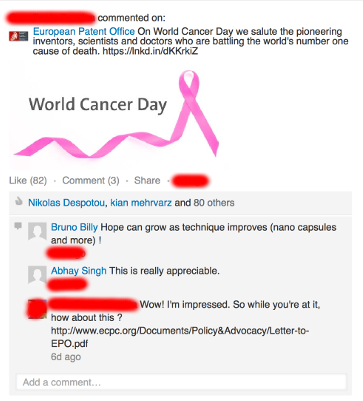

LAST week we wrote about the European Patent Office (EPO) killing literally poor women who have breast cancer. Years ago we dealt with these ethical problems [1, 2] that disturb EPO insiders, who thought they would be doing what's morally right when they joined the Office. Less than a day ago the EPO started playing with cancer again when it wrote: "On #WorldCancerDay we want to show the world some of the great minds that are working intensively to find a cure for this dreadful disease. http://bit.ly/2DSez3N Please spread the word!"
"This is not what the patent system was conceived for (e.g. denying access to life-saving cancer treatments)."Philipp Widera, writing in Kluwer Patent Blog, has just recalled what the EPO did regarding "patients with breast cancer" -- basically helping to deny them access to life-saving treatment they can afford. To quote Widera: "It all started in May 2017 when Ãâstrogenblocker (in English: “Estrogen Blocker”) had been handed down (docket-no I-2 W 6/17). The case can be regarded as a precursor of the Fulvestrant-decision as it concerned the PI-proceedings mentioned above. The underlying patent protected the use of Fulvestrant in the preparation of a medicament for the treatment of a specific group of patients with breast cancer (i.e. a Swiss-type claim). Based on the Pemetrexed-decision of the German Federal Supreme Court (docket-no X ZR 29/15, also known as Actavis v Eli Lilly), the Court of Appeal made it clear that Swiss-type claims are to be treated in the same way as so-called EPC 2000-claims. Hence Swiss-type claims are to be regarded as purpose-limited product claims (and not method claims)."
It is getting hard to tell, more so these days, if these European Patents are fake and void, as corrupt management at the EPO intentionally rushes/prods examiners to grant, passing the cost (or deaths) to the public. We'll say more about this in the next couple of articles. Here's another new example from IP Kat (also yesterday):
The patent EP (UK) 2073862 at issue claims a process for the preparation of a cell composition, comprising the steps of centrifuging whole blood in a separator tube, removing half of the platelet poor plasma from the top and re-suspending the remaining plasma and buffy coat to produce enriched platelet rich plasma (PRP). The claim specifies the type of separator tube and the centrifugal force to be used. In particular the claim specifies that the separator tube is either (1) a glass tube containing thixotropic gel and 0.10 M sodium citrate, or (2) a polyethylene terephthalate separator tube containing a highly thixotropic gel formed by a polymer mixture and anhydrous sodium citrate at 3.5 mg/mL. The inventive concept of the claim was said to reside in the resuspension step, which permits preparation of PRP from whole blood using only one centrifuge step.